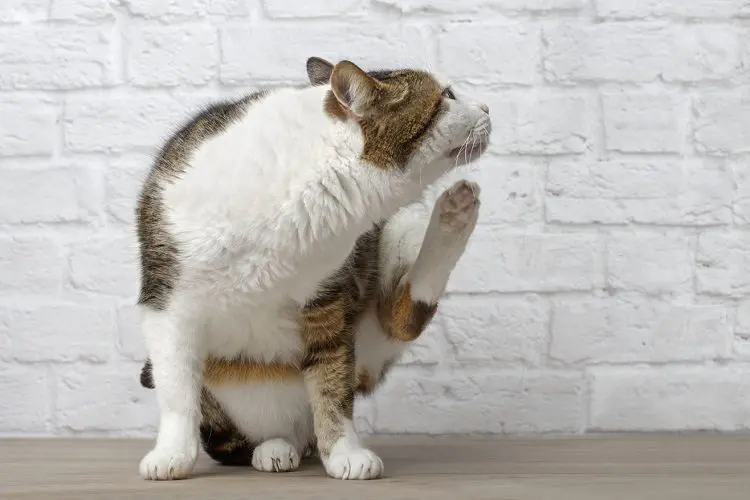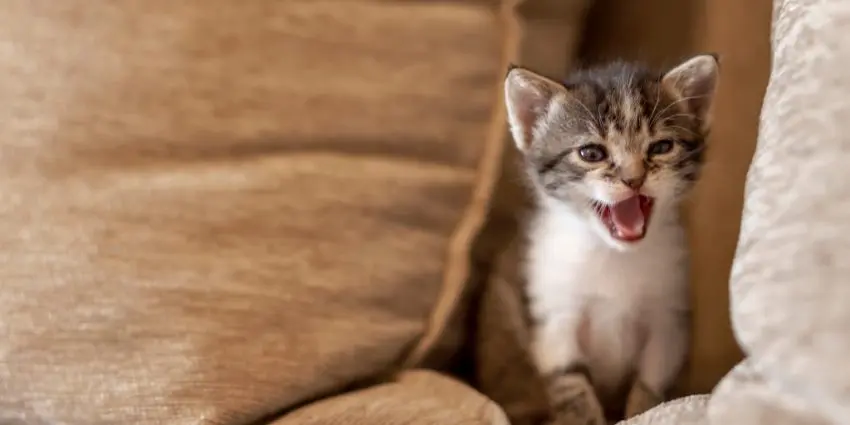Last Updated: 8 months ago
Why does my cat attack her tail?
Is your cat chasing her tail aggressively? Don’t worry. You’re not alone.
Read on to find out why she does it and whether it’s something to worry about.
Why Does My Cat Attack Her Tail?

Several pet owners have reported seeing their kittens chase their tails at very high speeds without resting.
Kittens chase and attack their tails because they view them as playthings.
But for adult cats, it could be signs of pain, an infection, a flea bite, or any other underlying medical condition.
They may even hiss and growl at their tails. And when they manage to “catch” it, they may end up biting and hurting themselves even further.
This behavior may lead to an infection, and the tail may even need to be mutilated.
Pay attention to your cat’s actions and body language to identify a sudden change and the reason they may be chasing their tail.
Common Reasons for This Behavior
Below are some of the reasons why your cat may be attacking her tail.
1. Fleas

A flea bite can be excruciating and itchy, and they’ll often leave bumps on the cat’s skin.
And to make it worse, adult fleas will often gather at the end of the cat’s tail.
So, when she’s aggressively chasing her tail, she may be trying to reach and scratch the flea-infested areas.
Overgrooming is also a sign of a flea infestation.
Once you’re sure this is the cause of the tail-chasing problem, you stop it using the usual remedies for getting rid of fleas.
These include medication, spot-on treatment, and cleaning your home.
Ensure you contact your vet for the most appropriate flea-treatment method for your cat.
2. Feline Hyperesthesia Syndrome (FHE)
This is a rare neurological disorder in cats that’s characterized by strange behavioral outbursts.
I mean, one moment, your cat is calm, and then all of a sudden, she starts frantically chasing her tailor, running around the house, very focused and with pupils dilated.
This behavior will last at least 20 to 30 seconds, and then she calms down.
You may also observe rippling on the cat’s body, strange vocalizations, salivation, or the cat urinating uncontrollably.
It’s not yet clear what causes this syndrome. It’s also not fatal, but they may engage in self-mutilation, which may lead to infections.
Some people associate it with sensitive nerve endings, and others associate it with compulsive disorders.
But according to Dr. de Lahunta of the Cornel University College of Veterinary Medicine, it may be a result of seizure disorders or Psychomotor Epilepsy.
You can control this behavior by maintaining a constant routine of feeding and petting times. This will help keep them calm.
But the vet can also recommend anti-seizure medication, calming medication, or any other medication suitable for your cat.
3. Allergies

Food allergies or allergies related to other environmental factors could be the reason your cat is attacking her tail.
Just like in people, allergies cause itchiness in various parts of the body. So she is probably trying to reach that end of the tail to ease the itchiness.
Other signs of allergic reactions include rashes and ear infections. If your cat is allergic to a particular type of food, obviously avoid feeding it to them.
You can also control allergic reactions with antihistamines and steroids.
4. Supracaudal Gland Hyperplasia (Stud Tail)
Cats have Supracaudal Glands at the base of their tails.
Within these glands are the Sebaceous glands that secrete Sebum, an oily substance that helps maintain healthy and soft hair.
Stud tail occurs when these glands secrete an excess amount of Sebum, which accumulates at the tail’s base.
When these oils combine with the tail’s hair, they cause a weird, itchy sensation that your cat can’t stand. It may also end up causing an infection.
Stud tail is common in unneutered male cats due to mating hormones, but it may also occur in some female cats.
The best way to avoid a stud tail is to maintain good overall hygiene for your cat.
Antiseborrheic shampoos are very effective at keeping this part of the tail clean. If the stud tail is infected, use antibiotics.
You can also consider neutering your male cats.
5. Playful Tail Chasing

Kittens are curious about moving objects. So when they don’t have a toy to chase and pounce on, they’ll start chasing their tails.
Adult cats may also exhibit this behavior from time to time, but most of them will outgrow it.
You can replace the tail with a scratching post, toy mice, or interactive toys.
6. Stress
Animals process stress differently.
Your cat may be stressed by changing a change in your house, a threatening wild animal, or adding a new cat to your household.
This stress may lead to redirected aggression where they attack and harm their tails.
Sometimes they attack their tails out of boredom, and interactive tails can help keep them entertained.
7. Other Infections

Your cat may also be suffering from other infections, either from an injury, infections in the anal glands, or arthritis.
These may cause some discomfort and aggressive tail chasing.
Once you know the cause of the infection, you can choose the appropriate treatment with the help of your vet.
What if She Attacks Another Cat’s Tail?
When kittens are playing, they’ll often chase at each other’s tails. But the tail-biting can be aggressive when they are fighting.
Watch her body language as she chases the other cat’s tail. Is she tense? Is she flicking her tail and growling or hissing?
If you observe this aggressive behavior, separate the cats before they cause more damage to each other.
Should I Be Worried?
Tail chasing is normal to some extent. If your adult cats did it as kittens, they are likely to chase their tail for fun occasionally.
But if they start attacking and biting it all of a sudden, then you should investigate the cause.
As I’ve explained above, most health conditions are accompanied by visible symptoms.
Check for blood, scratches, bite wounds, infections, or lethargy. But some conditions need X-rays, muscle biopsy, and other medical procedures.
This is after you’ve ruled out all the other reasons.


Interesting. I haven’t noticed any of my cats doing this when they were older. They did when they were smaller though.
Such interesting issues and I never knew this simple behavior could have so many causes. It could signal a serious issue so people need to pay attention.
So many different reasons that I would have never thought of. Cats are unique creatures.
This post is really informative, I’ve always wondered about that.
This is so interesting. I never knew this!
wow, they are so many reasons here, my cat doesn’t do this thankfully but will keep a lookout for these
This is so interesting! I didn’t know any of it. I had a kitten chase his tail in play but never any of these other events. I’m glad to know what to look for should it ever happen.
This was really interesting. I always wondered why cats attack their tails. Now it all is clearer, thanks!
This is interesting to know. Sometimes one of my cats will chase its tail. They don’t really attack it, just chase it once in a while.
I always thought that cats are playing this way and nothing else. It was interesting to discover these things!